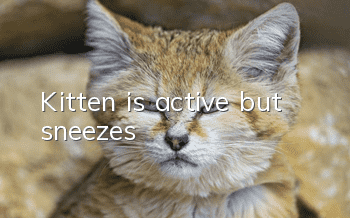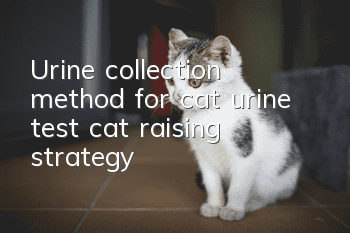Why is the cat vomiting and diarrhea and not eating? Beware of feline distemper and feline infectious peritonitis!

Today, the editor will share some knowledge about feline infectious peritonitis.
First of all, many novice cat owners will encounter the problem of cats not eating, vomiting or diarrhea during the process of raising cats. My cat at home is vomiting and has diarrhea. What is the disease?
To be honest, many pet doctors are reluctant to answer such questions, because there are many causes of vomiting and diarrhea in cats. Without testing, no one is willing to directly say: Your cat has feline-to-feline transmission, or your cat has feline distemper! Such a reply is very imprecise. Maybe, cats without these two diseases will also suffer from feline distemper. Vomiting and diarrhea.
If you encounter this situation, it is best to go to the hospital for an examination. Sometimes the data obtained from the examination is more convincing than the doctor's experience.
If the cat is just vomiting and not eating, the possible reasons are as follows:
1. Gastrointestinal problems and indigestion.
2. I ate a hairy ball.
3. Cat plague.
4. Feline infectious peritonitis.
5. Cat proctitis.
6. Internal parasites.
········
Other diseases may also cause cats to vomit, have diarrhea and skip meals. These six reasons are relatively common.
The symptoms of feline distemper and feline infectious peritonitis are relatively similar. Only in the hospital, a test strip test and routine blood examination are done, and the doctor can give a conclusion based on the data results.
Among cat infectious diseases, dangerous diseases with extremely high infectivity and fatality rate are none other than feline distemper and peritonitis! In order to keep cats away from these two dangerous infectious diseases, all cat scavengers must also take care of them. Only those you know will do!
What we need to know about cat plague:
Feline distemper, scientifically known as feline panleukopenia, is called "feline distemper" in English. Distemper refers to the instability of body temperature, because cats suffering from feline distemper will have intermittent fever, so it is called this in English.
The characteristics of the feline plague virus are that the particles are very small, so it is very easy to spread through flying droplets. As long as a sick cat sneezes, coughs, or even comes into contact with secretions or excretions, he or she may be infected with the virus, which can remain in the environment for about half a year.
Faced with such a wide range of infection routes,Viruses with strong survivability can really only be prevented by vaccination! Among the vaccinations for cats, whether it is three-in-one or five-in-one, they all include feline plague, so the vaccination must not few.
When a cat develops fever, vomiting, bloody stools, and mental depression, these are actually caused by a large decrease in the number of white blood cells in the cat's blood. The official scientific name of feline distemper is "feline panleukopenia". This disease will cause the cat's white blood cells to decrease rapidly, from the normal 6000~8000 to less than 1000. When white blood cells drop significantly, immunity weakens, which can easily lead to invasion and infection by other bacteria. In other words, the above symptoms are all caused by the breakdown of the cat’s immune defense line.
Treatment and prevention of cat plague
Unfortunately, there are currently no directly effective drugs for the treatment of feline distemper, but it is not an incurable disease! Once a cat is confirmed to be infected with feline distemper, the first thing to do is to isolate it from other cats, and then to supplement nutrition, such as Inject an intravenous drip and give some antibiotics to avoid continued infection; as long as the cat is provided with enough calories and nutrients to improve immunity, usually in about 7 to 10 days, the cat's body will slowly develop antibodies to deal with feline plague, and then it will recover. possible.
Although cat plague is extremely contagious, the good news is that the cat plague vaccination is very effective! Therefore, we still have to remind everyone to vaccinate their cats regularly. Don’t think that cats ignore the importance of vaccinations if they don’t go out at all. Sex!
Finally, I would like to remind everyone that because the feline distemper virus has a very strong survivability, if a cat in your home is infected with feline distemper, you must use diluted bleach to disinfect the environment and utensils! It is best to replace the entire batch of utensils with new ones to effectively prevent infection. Other cats. If you have a cat with feline distemper in your home, it is best not to bring new cats into the house for half a year!
What we need to know about feline infectious peritonitis (FIP):
Feline infectious peritonitis (FIP) is caused by coronavirus. Coronavirus can be spread through feces, saliva, etc. Because cats have the habit of removing sand. If a companion has coronavirus, it is easy to get it on their hands, feet or body, then other cats may have it. They may be infected by ingesting the virus while grooming each other.
Coronavirus can also be transmitted vertically. If the mother has the virus, the kittens will also have it. In other words, the coronavirus is also quite transmissible.
Feline infectious peritonitis is divided into dry type and wet type. The initial symptoms are fever, vomiting, diarrhea, etc. As the disease progresses, dry peritonitis will appear like lymph nodes or lumps in the abdominal cavity, while wet peritonitis will make the belly appear enlarged and ascites. symptom. Because the virus attacks the lymph nodes and liver, jaundice may also occur.Phenomenon.
Regarding the treatment of feline infectious peritonitis, to be honest, the cure rate is quite low. Clinically, fluorescent dyes, serum, interferon and other methods can be used for treatment, but in my personal experience, the results are not very good. Basically, the quality of life of cats after being infected with peritonitis is very poor. Once a cat develops jaundice or ascites, it is almost impossible to cure it.
Since the cure rate is very low, is there a vaccine as effective as the feline distemper vaccine to prevent feline infectious peritonitis? The answer may disappoint everyone! Some manufacturers have previously launched peritonitis drops, but this vaccine has been quite controversial. It is large and the effect seems to be quite limited, so it is not recommended that you let your cat use peritonitis drops.
Although FIP can be said to be an incurable disease in cats, and there is no way to even prevent it, you don’t need to be too pessimistic! As long as you maintain your cat’s good living habits, a balanced diet, and pay attention not to make too many changes in the living environment, Try not to let your cat’s immunity decline, and you poop collectors don’t need to worry too much!
Finally, the editor reminds all pet owners that before raising cats, they must be vaccinated. This can prevent diseases and save a lot of money, because the cost of treatment in the hospital is relatively high. If the cat does not get sick, it will be vaccinated. You save money.
I hope this article can help some cat owners.
- What should I do if my newly adopted kitten keeps meowing?
- How can a thin cat gain weight? Learn about the guide to weight gain for cats!
- What is the meaning of cats in China?
- How often do newborn kittens defecate?
- How long does it take for a kitten to grow up?
- Can cats eat pomelo?
- Be careful about parasites when adopting stray cats
- How to feed a newly weaned cat?
- Why does a kitten have a smelly mouth?
- Where do cats press to induce vomiting?



